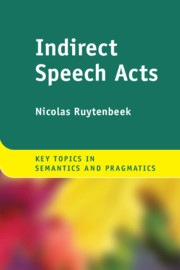Book contents
- Indirect Speech Acts
- Key Topics in Semantics and Pragmatics
- Indirect Speech Acts
- Copyright page
- Contents
- Acknowledgements
- Tables
- Figures
- Abbreviations
- Introduction
- 1 Classic Speech Act Theoretic Approaches
- 2 The Semantics of Sentence-Types
- 3 Cognitive and Relevance-Based Approaches
- 4 The Comprehension of ISAs
- 5 Indirectness, Politeness and the Social Context
- 6 Computational and Artificial Intelligence Approaches to Indirectness
- Conclusion
- Glossary
- References
- Index
Introduction
Published online by Cambridge University Press: 21 May 2021
- Indirect Speech Acts
- Key Topics in Semantics and Pragmatics
- Indirect Speech Acts
- Copyright page
- Contents
- Acknowledgements
- Tables
- Figures
- Abbreviations
- Introduction
- 1 Classic Speech Act Theoretic Approaches
- 2 The Semantics of Sentence-Types
- 3 Cognitive and Relevance-Based Approaches
- 4 The Comprehension of ISAs
- 5 Indirectness, Politeness and the Social Context
- 6 Computational and Artificial Intelligence Approaches to Indirectness
- Conclusion
- Glossary
- References
- Index
Summary
Language is much more than a simple code for exchanging information. It isfirst and foremost used to interact with one another through the performanceof actions such as warning about a state of affairs (Your train isleaving in five minutes), asking a question (When doesyour train leave?), wishing someone good luck (Have anice trip!), telling someone what to do (Show me yourtrain ticket). These actions, which are accomplished by meansof written or spoken utterances, are called ‘speech acts’(SAs), following the tradition in linguistic pragmatics and the philosophyof language.
- Type
- Chapter
- Information
- Indirect Speech Acts , pp. 1 - 4Publisher: Cambridge University PressPrint publication year: 2021

